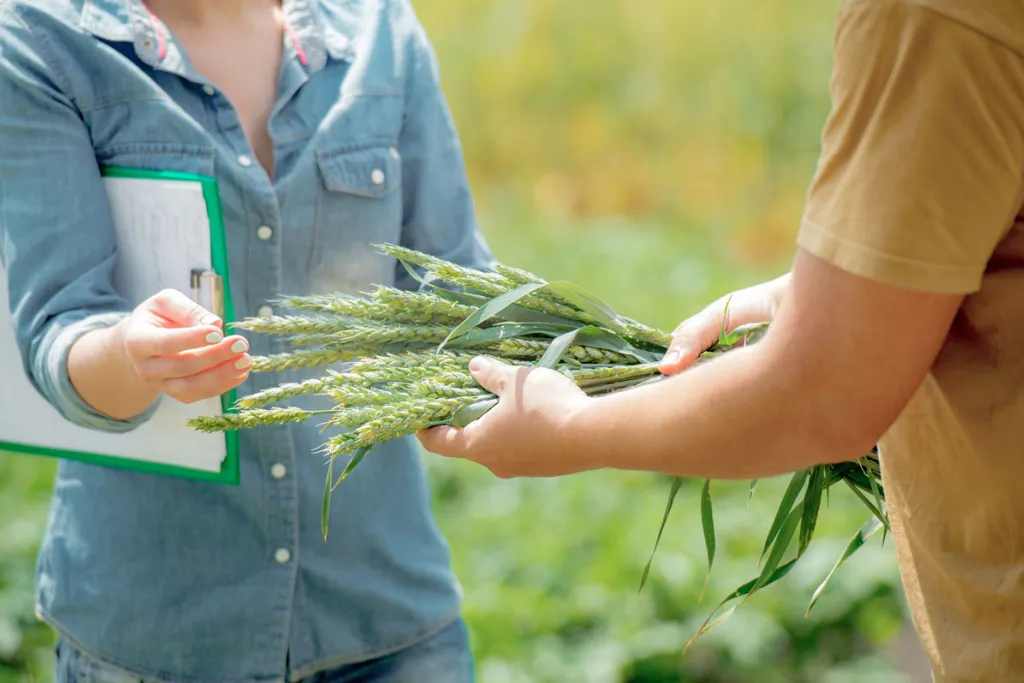Field and forage crops are grown on most of the more than 200 million acres of harvested cropland in the United States. These crops provide the food, feed, fuel, and fiber for domestic consumption, and they are a major component of the U.S. export market.
Uses of agronomic and forage crops for industrial purposes are substantial and increasing. Competition from world markets has kept the price of farm commodities low, while the cost of production continues to increase. To stay competitive, farmers must maintain a balance between yield and input costs, as well as monitor environmental impacts. These challenges are likely to intensify. Therefore, the need for NIFA support for agronomic research, extension, and education is greater now than ever before.
Crop Selection, Development, and Management
The success of agronomic crop production in various locations in the United States depends on the availability of plant varieties and hybrids specifically adapted to local production conditions. These cultivars provide resistance to major pests and diseases, produce acceptable yield and quality, and have agronomic characteristics that are compatible with existing production systems. Management of these crops across diverse environments to improve sustainability is also critical.
Crop selection, development, and management represent a major use of NIFA federal Hatch and multi-state formula grants at land grant university agricultural experiment stations. Most agricultural experiment stations have active breeding and management programs focused on the more important crops grown in their state.
Research activities in this area span a wide range, including:
- Development of new cultivars adapted to local conditions, a changing climate, and with superior resistance to known or emerging biotic and abiotic stresses
- Evaluation of practices and management methods to improve economic, environmental, and social sustainability in agriculture
- New planting, cultivating, harvesting, and processing technologies for use in crop and forage production systems
- Identification of genes of agronomic importance
- Development of value-added products
- New methods to estimate forage yield and quality to support marketing and reduce producer risks
- Improved water and nutrient use efficiency traits for crop varieties that result in decreased irrigation and fertilizer demand while maintaining yield and quality
- Multiple production components managed to improve profitability, productivity, and resource stewardship
Funded Projects
- Alfalfa Seed and Alfalfa Forage System Program (ASAFS)
- Canola Research (HW)
- Foundational Knowledge of Plant Products (A1103)
- Organic Agriculture Research and Extension Initiative (113.A)
- Organic Transitions (112.E)
- Physiology of Agricultural Plants (A1152)
- Plant Breeding for Agricultural Production (A1141)
- Potato Research (AN)
Program Specific Resources
- Agriculture and Food Research Initiative Programs
- Alfalfa Seed and Alfalfa Forage System Program
- Potato Research
- Organic Programs
- Supplemental and Alternative Crops
- Sustainable Agriculture Program
News
- Revealing the Diversity of Genes Behind Better Alfalfa Hay
- U.S. Canola Research Aims to Increase Production
- Development of New Potato Varieties
- Taking Tillage out of Organic Grain Crop Production
- High-Speed Precision Seeding Technologies
Highlights
- Canola Research
- Grassland 2.0
- Cattle Grazing and Soybean Yields
- Ground Pressure Resulting from Equipment in Alfalfa Fields
External Resources
- American Society of Agronomy
- International Plant Nutrition Institute
- North American Alfalfa Improvement Conference
- Northeastern Regional Association of State Agricultural Experiment Station Directors
- Society for Range Management
- Sustainable Agriculture Research and Education (SARE)
- Weed Science Society of America
- Western Association of Agricultural Experiment Station Directors
National Commodity Associations and Councils
- American Forage and Grassland Council
- American Peanut Council
- American Pulse Association
- American Soybean Association
- American Sugarbeet Association
- National Association of Wheat Growers
- National Barley Growers Association
- National Corn Growers Association
- National Cotton Council
- National Grain and Feed Association
- National Hemp Association
- National Sorghum Producers
- National Sunflower Association
- The Potato Association of America
- U.S. Canola Association
- US Dry Bean Council
- US Rice Producers Association
- USA Rice

